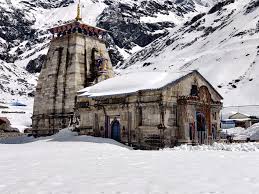The Badrinath Temple, one of the most sacred temples in Hinduism, is located in the Chamoli district of Uttarakhand at an elevation of 3,300 meters (10,827 feet) above sea level. It is dedicated to Lord Vishnu and forms an essential part of the Char Dham Yatra and the Chota Char Dham pilgrimage circuit. The temple’s origins and history are deeply rooted in Hindu mythology and centuries-old traditions.
The Badrinath Temple, one of the most sacred temples in Hinduism, is located in the Chamoli district of Uttarakhand at an elevation of 3,300 meters (10,827 feet) above sea level. It is dedicated to Lord Vishnu and forms an essential part of the Char Dham Yatra and the Chota Char Dham pilgrimage circuit. The temple’s origins and history are deeply rooted in Hindu mythology and centuries-old traditions.
Mythological Significance
According to Hindu mythology, the origins of the Badrinath Temple date back to ancient times. It is believed that Lord Vishnu, in his incarnation as Narayan, performed severe penance here under a Badri (berry) tree. Goddess Lakshmi, Vishnu’s consort, stood by and protected him from harsh weather conditions by transforming herself into a Badri tree. Impressed by her devotion, Vishnu named the place “Badrinath,” meaning “Lord of the Berries.”
There is also a strong connection between the Mahabharata and Badrinath. Legend has it that after the great war at Kurukshetra, the Pandavas, in quest of salvation and heaven, traveled along this sacred place. Even the writer of Mahabharata, Ved Vyasa, is said to have been residing around Badrinath and is believed to have composed the epic there.
Historical Background
The origins of the Badrinath Temple as a physical structure can be traced back to Adi Shankaracharya, the great 8th-century Hindu philosopher and theologian. He is credited with establishing the temple in its present form around the 9th century.
Shankaracharya, a key figure in the revival of Hinduism, established four mathas (monastic centers) in different parts of India, one of which is in Badrinath. It is believed that Shankaracharya discovered the idol of Lord Badrinarayan (Vishnu) in the Alaknanda River and enshrined it in a cave near the hot springs of Tapt Kund. Later, the idol was moved to the present temple location, which was constructed by subsequent rulers and kings over the centuries.
The temple has been renovated multiple times, notably by the Garhwal kings, who played a significant role in its development and preservation.
Other Article
Architectural Features
The Badrinath Temple is a classic example of North Indian temple architecture. The temple has a conical shape, topped with a small cupola and a gold gilt roof. The temple’s facade features intricate carvings and vibrant imagery that reflect the region’s rich cultural heritage. The temple’s sanctum houses a 1-meter-tall black stone idol of Lord Vishnu, seated in a meditative posture. The idol is flanked by other deities, including Nar and Narayan.
Temple Rituals and Worship
The Badrinath Temple follows strict rituals and customs, with worship and ceremonies conducted according to Vedic traditions. In winter, the Badrinath idol is moved to Narendra Nagar or Joshimath for worship in a winter shrine.
The Badrinath Temple is a classic example of North Indian temple architecture. The temple has a conical shape, topped with a small cupola and a gold gilt roof. The temple’s facade features intricate carvings and vibrant imagery that reflect the region’s rich cultural heritage. The temple’s sanctum houses a 1-meter-tall black stone idol of Lord Vishnu, seated in a meditative posture. The idol is flanked by other deities, including Nar and Narayan.
Modern Day Pilgrimage and Importance
Badrinath is a spiritual center and a key destination in the Chota Char Dham pilgrimage, alongside Yamunotri, Gangotri, and Kedarnath. Thousands of devotees undertake this pilgrimage each year, making it one of India’s most popular religious circuits.
Recently, the Indian government and local authorities improved access to Badrinath with better roads and infrastructure for pilgrims. Despite these developments, the region’s natural beauty and the temple’s ancient charm still attract visitors seeking spiritual peace and blessings. The Badrinath Temple embodies centuries of devotion and faith, representing Hinduism’s spiritual and cultural essence as a vital pilgrimage center.
Indian government and local authorities improved access to Badrinath with better roads and infrastructure for pilgrims. Despite these developments, the region’s natural beauty and the temple’s ancient charm still attract visitors seeking spiritual peace and blessings. The Badrinath Temple embodies centuries of devotion and faith, representing Hinduism’s spiritual and cultural essence as a vital pilgrimage center.
 Diverse Perspectives: Insights & Stories Exploring Ideas, Sharing Knowledge
Diverse Perspectives: Insights & Stories Exploring Ideas, Sharing Knowledge





